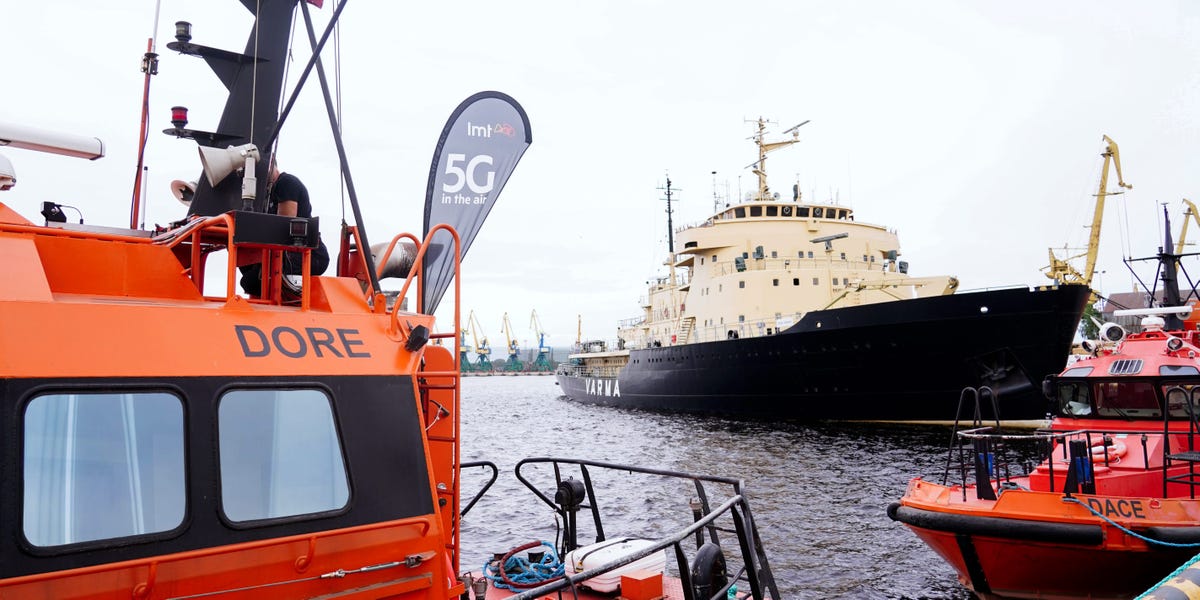
Take a look at our newest merchandise
Within the Center Ages, seafarers would sail down the Daugava River to take refuge from the tough winds and waves of the Baltic Sea. They’d anchor their ships, which carried items like corn, conceal, and flax, in a small pure harbor within the metropolis of Riga.
At this time, the harbor within the Latvian capital continues to be a bustling port, though cargo ships and autonomous drones have changed the sails and oars. It was designated a freeport, or free commerce zone, in 2001, which signifies that companies utilizing the port could also be exempt from sure taxes and tariffs. Greater than 2,500 ships handed by way of the harbor in 2024.
Ansis Zeltins, the CEO of the Freeport of Riga Authority and the chairman of the European Sea Ports Group, stated automation is likely one of the largest areas of innovation within the delivery trade. As an example, uncrewed floor autos, generally often called sea drones, can carry out routine duties like ship inspections and monitor water air pollution ranges.
However distant and autonomous expertise requires a quick, dependable connection.
“The quantity of knowledge that must be processed in at present’s ports is immense and constantly rising,” Zetlins stated. “Fashionable logistics, in addition to port and maritime safety options, require the safe change of knowledge between all stakeholders in actual time.”
However that is not straightforward when connecting ships, drones, and the port throughout the ocean.
“Ships are transferring objects,” Zeltins stated. “Which means, technologically, there is a problem with the sign.”
The port used to depend on WiFi and 4G to attach ships and drones to the mainland, however in 2020, it teamed up with LMT, a Latvian telecoms firm, to roll out 5G connections throughout the port.
Courtesy of the Freeport of Riga
Extra units, quicker speeds
5G is a wi-fi expertise that makes use of radio waves to transmit knowledge.
“For almost all of individuals such as you and me, 5G is just not that large of an improve from 4G or WiFi,” Chris Karaplis, the CEO of Merely Embedded, a expertise consulting agency, instructed Enterprise Insider. “Whereas speeds may be barely quicker, the most important differentiator is its capability to assist extra units, so your connection will not decelerate when extra persons are on the community.”
5G can assist as many as 2.6 million units per sq. mile.
“For industrial purposes in sectors reminiscent of manufacturing, logistics, and good cities, 5G generally is a recreation changer,” Karaplis stated. “With the ability to ship massive packets of knowledge extra reliably and quicker, in the end enhancing efficiencies, is a large profit for infrastructure or logistics-critical companies.”
At the beginning of the 5G rollout, LMT and Freeport of Riga constructed a non-public 5G community throughout the Baltic Container Terminal on the mainland. They changed 22 WiFi entry factors with only one central management system and two outside antennas.
Beneath the brand new 5G system, Vilciņš stated knowledge transmission speeds grew to become greater than 10 instances quicker. This resulted in using different expertise in port operations, reminiscent of changing handheld radio communications with push-to-talk, an answer that permits the transmission of pictures and movies in addition to sound.
“There have been quick enhancements in enterprise processes,” Kārlis Vilciņš, the top of system integration enterprise at LMT, instructed BI in an e-mail. Vilciņš stated earlier than the change, container attain stackers, or autos used to move containers throughout the port, idled and waited for a steady connection to deal with containers, which frequently brought about delays.
Courtesy of the Freeport of Riga
‘Multi-hop’ connections
The true problem was connecting the ships in transit. They used a “multi-hop” technique, the place ships function floating telecom base stations. One vessel connects to the mainland’s 5G antenna, then passes that connection to the following ship, and so forth.
LVR Flote, a port companies supplier primarily based in Riga, first efficiently examined the strategy in November 2023 utilizing LĪVA, the primary 5G-equipped ship on the Baltic Sea. This previous July, the corporate carried out a extra advanced take a look at, connecting two ships with an airborne drone that transmitted real-time seabed surveys and video footage again to the port. These hydrographic measurements are crucial for protected navigation and port operations.
“5G gives an choice for real-time controls,” Zeltins stated. “It is a lot safer and extra responsive.”
Ships utilizing the multi-hop approach can join as much as 18 miles aside. As much as 5 ships may be linked up on this approach, extending the entire community vary at sea to greater than 100 miles.
“This can be a main enchancment as a result of such expertise has not been deployed at sea earlier than,” Arturs Lindenbergs, the top of the innovation improvement division at LMT, stated in an e-mail.
Trying forward, Zeltins needs to harness the quicker connection to deliver new expertise to the Freeport of Riga. As an example, the port is testing a Distant Operations Middle platform for autonomous maritime techniques.
“Our collaborative efforts have the potential to make the port of Riga a novel take a look at mattress for next-generation maritime applied sciences, improve high-value-added exercise on the port, and entice high-value investments and new income streams,” he stated.





![[2024] MSI Aegis R2 C14NUF9-829US (Intel Core i9-14900F, 128GB DDR5 RAM, 2X 2TB NVMe SSD, NVIDIA GeForce RTX 4070 Ti Super, Windows 11) Gaming Desktop PC](https://m.media-amazon.com/images/I/81i1KVslX4L._AC_SL1500_.jpg)







